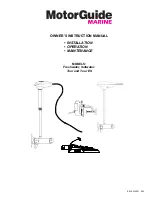
UG-486
Evaluation Board User Guide
Rev. 0 | Page 4 of 8
DATA I/O
There are two data I/O pins on each side of the board. For
example, examining Channel A on Side 1, Figure 3 shows the
following structures, starting from each I/O connector:
•
A position for a pull-down resistor or termination to be
installed in R2A and R4A.
•
A 0 Ω resistor at R6A connects the trace to the SMA
connector and termination. This allows extra trace length
and components to be removed when capacitance must
be controlled.
•
Two positions for connection of the trace to V
DDP
or GND.
R8A and C1A are available for a pull-up or pull-down
resistor or for a capacitive load when the I/O is an output.
•
There is the P1A test point, with a 200mil pitch. This is for
hard wiring inputs or installing a Tektronix active probe
header.
•
Position R10A allows interconnection of Channel A and
Channel B. Inputs on the same side can share a single off
board connection, or an output signal can be wrapped back
to an input.
The same set of structures is present on each channel, allowing
a wide range of tests to be conducted with minimum config-
uration.
EMI MITIGATION
The PCB implements EMI mitigation techniques discussed
in the
AN-0971 Application Note
to demonstrate the recom-
mended board layout options for this device. These techniques
include stitching capacitance and edge guarding.
Stitching Capacitance
Capacitance between the primary and secondary power
and ground planes is the most effective way to reduce high
frequency emissions from an
iso
Power device. Figure 2
shows how the inner layers of a PCB can create this stitching
capacitance by overlapping inner layer metal to create an
extremely low inductance capacitance. The green area
shows the active coupling area.
Edge Guarding
Providing guard rings laced together with vias on each layer of
the primary side reduces edge emissions from the PCB stack-up.
This addresses emissions due to differential currents flowing in
the ground planes from reaching the edge of the PCB where
they could radiate. Figure 4 shows the top layer guard ring and
the bottom layer ground fill as well as the regularly spaced vias
in the guard ring that creates a cage type structure to reflect
inter-plane emissions back into the PCB. Figure 5 shows the
top layer power fill along with its vias to the Layer 3 power
plane. This top layer power fill adds distributed capacitance
as well as shielding for the layer below.
HIGH VOLTAGE TESTING
This PCB is designed in line with 2500 V basic insulation
practices. High voltage testing beyond 2500 V is not recom-
mended. Appropriate care must be taken when using this
evaluation board at high voltages, and it should not be relied
on for safety functions because it has not been hi-pot tested
or certified for safety.


























